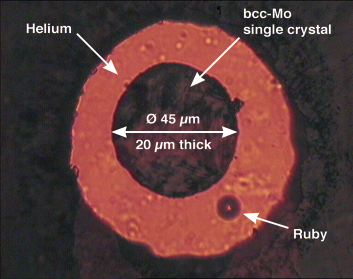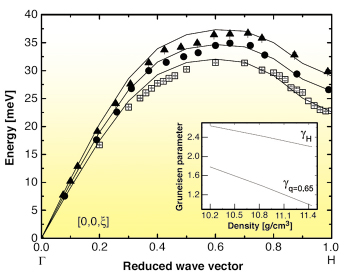- Home
- Users & Science
- Scientific Documentation
- ESRF Highlights
- ESRF Highlights 2006
- High Resolution and Resonance Scattering
- Pressure dependence of phonon anomalies in molybdenum
Pressure dependence of phonon anomalies in molybdenum
The 4d transition elements exhibit a wide variety of phonon dispersion effects and thus provide a fertile testing ground for modern theoretical descriptions of lattice dynamics. Molybdenum, which is a bcc 4d transition metal, has been the focus of numerous theoretical and experimental studies of electronic structure, lattice dynamics, elasticity and strength. While the theoretical treatments of the lattice dynamics have been successful at describing many of the experimental observations, the large softening near the H-point has remained an open problem. Studies by neutron scattering at room conditions and as a function of temperature to 1203 K have shown that the H-point phonon displays anomalous stiffening with increasing temperature, which has been proposed to arise from either intrinsic anharmonicity of the inter-atomic potential or electron phonon coupling. While lattice compression provides a very convenient way to probe the interatomic potential, the requirement of relatively large samples for neutron scattering experiments has generally limited the range of pressures over which direct lattice dynamical information could be gathered. With the advent of inelastic X-ray scattering (IXS) techniques, these difficulties have to a great degree been overcome. Thus, in order to address the nature of these phonon anomalies, we performed both a high-pressure experimental study on beamline ID28 probing the lattice dynamics of molybdenum, as well as a new theoretical treatment of the phonon dispersions.
IXS experiments on single crystals at high pressure are quite unforgiving with respect to the sample quality and the high pressure hydrostatic environment. Thus, we have developed new techniques for preparing extremely small single crystals (45 micrometres in diameter by 20 micrometres thick) of high crystalline quality (Figure 12) [1]. The crystals were loaded into diamond anvil cells (DAC), using helium as a pressure-transmitting medium to ensure hydrostatic pressure conditions and the preservation of the crystal quality to pressures as high as 40 GPa.
 |
|
Fig. 12: Mo single crystal loaded in helium pressure medium. Photomicrograph was taken of the sample in situ at high pressure in the DAC. |
We collected the complete phonon dispersion of Mo to 37 GPa, but here we will only focus on the observed decrease in the relative magnitude of the H-point phonon anomaly upon compression (Figure 13). This collapse in molybdenum is possibly best illustrated by the comparison of the pressure dependence of the H-point phonon energy in bcc-Fe. For similar volume compressions, we find a ~6% and ~22% increase in the zone boundary mode in Fe and Mo respectively [2]. A number of lines of evidence indicate that the explanation for this is a decrease in the magnitude of electron phonon coupling on compression. Our DFT calculations treat the p-like bands as part of the ion core, and yet, they accurately predict the pressure evolution of the H-point anomaly, thus ruling out a significant role for the p-like bands, as instead previously suggested. Furthermore, upon compression at room temperature, the thermal excitations are both minimal and decrease with increasing pressure. This, in light of the fact that the computational methods used here are within the quasi-harmonic approximation, indicates that intrinsic anharmonic contributions are unlikely to be responsible for the anomaly. Conversely, we suggest that the nested electronic bands 3 and 4 near the Fermi level at one atmosphere, give rise to the anomaly. Evidence for this comes from the sensitivity of the calculated H-point phonon energy to the Gaussian broadening of the electron density of states. Since the Fermi energy level increases with pressure, those nested bands will be lower relative to the Fermi level (effectively moving outside of kBT of the Fermi level). Moreover, compression induces band broadening and consequent weakening of the electron-phonon coupling. This sensitivity is to be expected if electron-phonon coupling is an important effect in the anomaly.
 |
|
Fig. 13: Phonon dispersion in Mo along the [100] directions at high pressure. Filled symbols are IXS data (circle: 17 GPa; triangles: 37 GPa); the unfilled squares are inelastic neutron scattering data at 1 atm. Our calculations are shown as solid lines. The reduction of the anomaly with pressure is further illustrated in the inset, comparing the evolution with density of the Grüneisen parameter for q ~ 0.65 (maximum of the dispersion) and at the H point (q = 1). |
In conclusion, we have shown how and why the peculiar lattice dynamics of molybdenum become more ‘regular’ upon compression, resulting in a much more ’normal’ bcc metal at high pressures. This possibly explains the extraordinary stability (to pressures in excess of 400 GPa) of molybdenum in the bcc structure.
References
[1] D.L. Farber, D. Antonangeli, C. Aracne, J. Benterou, High Pressure Research 26, 1 (2006).
[2] S. Klotz and M. Braden, Physical Review Letters 85, 3209 (2000).
Principal Publication and Authors
D. L. Farber (a), M. Krisch (b), D. Antonangeli (a), A. Beraud (b), J. Badro (a,c), F. Occelli (a) and D. Orlikowski (a), Physical Review Letters 96, 115502 (2005).
(a) Lawrence Livermore National Laboratory, Livermore (USA)
(b) ESRF
(c) Institut de Minérologie et de Physique des milieux condensés, Univ. Paris (France)



